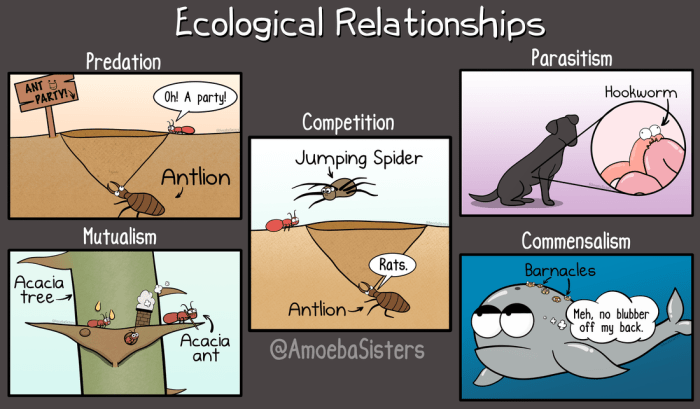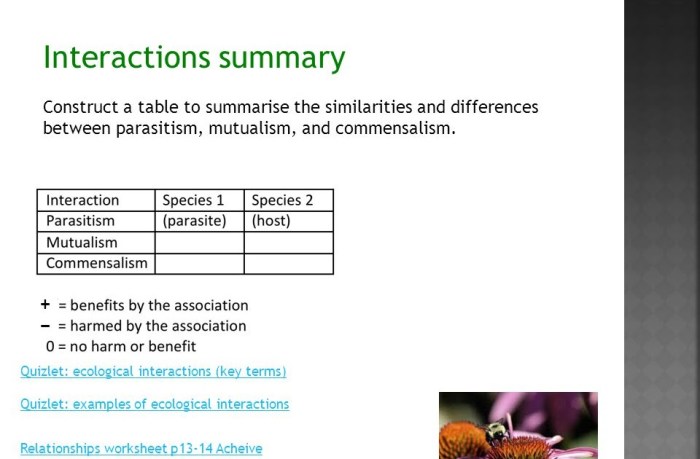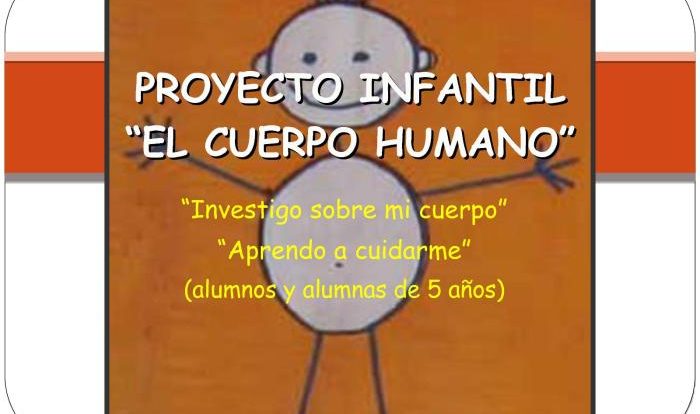Discover the intricacies of ecological relationships through the POGIL Ecological Relationships Answer Key, an indispensable guide that unlocks the secrets of nature’s interconnectedness. This comprehensive resource empowers educators and students alike to delve into the dynamic interactions between organisms, unraveling the complexities of competition, predation, mutualism, and commensalism.
POGIL’s interactive approach fosters a deeper understanding of ecological concepts, enabling learners to engage with real-world examples and apply their knowledge to conservation and environmental management.
Ecological Relationships: Concepts and Types

Ecological relationships refer to the interactions between different organisms in an ecosystem. These relationships can be categorized into several types, each with its own unique characteristics and consequences.
Types of Ecological Relationships
- Competition:When two or more organisms utilize the same limited resources, such as food or shelter, they enter into competition. This competition can be intense, leading to reduced survival or reproductive success for one or both organisms.
- Predation:A predator-prey relationship exists when one organism (predator) hunts and consumes another (prey). This interaction can have a significant impact on both predator and prey populations, influencing their abundance and distribution.
- Mutualism:In mutualistic relationships, both species benefit from their association. For example, certain plant species form symbiotic relationships with fungi, which help them absorb nutrients from the soil in exchange for carbohydrates produced by the plant.
- Commensalism:Commensalism occurs when one species benefits from an interaction while the other is neither harmed nor benefited. For instance, epiphytes (plants that grow on other plants) utilize the support of host plants without causing any harm to them.
POGIL (Process Oriented Guided Inquiry Learning)
POGIL is a student-centered teaching approach that emphasizes active learning and guided inquiry. It involves students working in small groups to investigate a topic and construct their own understanding through hands-on activities and discussions.
POGIL for Ecological Relationships, Pogil ecological relationships answer key
POGIL can be effectively used to teach ecological relationships. Students can engage in activities that simulate different types of relationships, such as competition experiments or predator-prey models. Through these activities, they can observe and analyze the dynamics of these interactions and develop a deeper understanding of their ecological significance.
POGIL Lesson Plan: Ecological Relationships
A POGIL lesson plan on ecological relationships typically includes:
- Introduction to the concept of ecological relationships
- Activities to explore different types of relationships
- Group discussions and presentations
- Assessment of student understanding through quizzes or assignments
Answer Key: Analysis and Discussion: Pogil Ecological Relationships Answer Key

The answer key for the POGIL lesson plan provides solutions to the activities and questions posed during the lesson. It serves several purposes:
- Analysis of Key Concepts:The answer key helps students identify and understand the key concepts and principles related to ecological relationships.
- Assessment of Student Understanding:By comparing their responses to the answer key, students can assess their own understanding of the material and identify areas where they need further clarification.
- Facilitation of Class Discussions:The answer key can facilitate class discussions by providing a common reference point for students to share their insights and perspectives on ecological relationships.
Examples and Applications

Ecological relationships are ubiquitous in nature and play a crucial role in maintaining ecosystem balance and biodiversity. Understanding these relationships is essential for conservation and environmental management.
Real-World Examples
- Competition between lions and hyenas for prey in the African savanna
- Mutualism between nitrogen-fixing bacteria and legumes in agriculture
- Commensalism between barnacles and whales in the ocean
Importance and Applications
Ecological relationships have significant implications for:
- Ecosystem Functioning:They determine the flow of energy and nutrients through ecosystems, influencing productivity and stability.
- Biodiversity Conservation:Understanding ecological relationships is crucial for preserving species diversity and preventing species extinctions.
- Environmental Management:It helps guide conservation efforts, habitat restoration, and sustainable resource use practices.
Popular Questions
What is the significance of ecological relationships?
Ecological relationships are crucial for maintaining ecosystem balance and ensuring the survival of species. They shape the distribution, abundance, and behavior of organisms, influencing the overall dynamics of ecological communities.
How does POGIL enhance the teaching of ecological relationships?
POGIL’s student-centered approach promotes active learning and fosters a deeper understanding of ecological concepts. Through hands-on activities and guided inquiry, students engage with real-world scenarios, analyze data, and develop critical thinking skills.
What are the benefits of using the POGIL Ecological Relationships Answer Key?
The answer key provides educators with a structured framework for assessing student understanding and identifying areas for improvement. It also facilitates self-assessment, allowing students to gauge their comprehension and reinforce key concepts.


